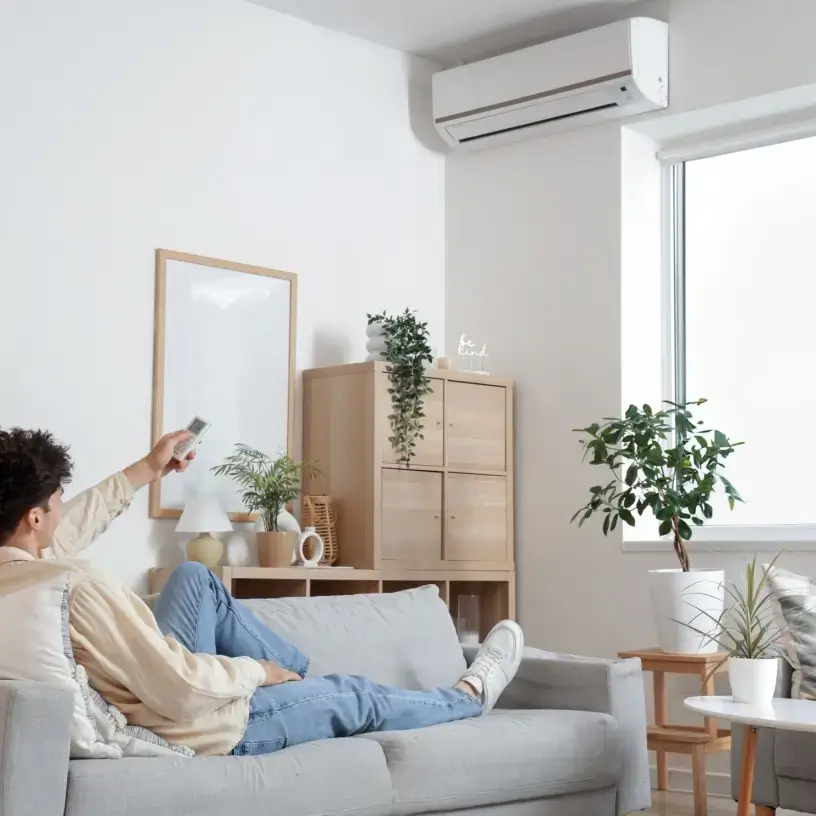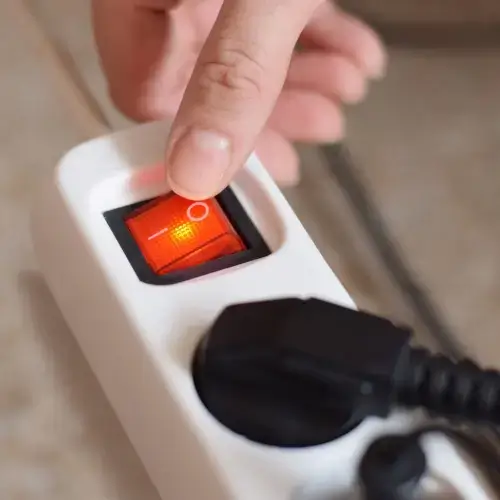Home / Compare Electricity &… / How to save money on ele…




Key takeaways
- Understand your energy usage and consider replacing your appliances with more energy-efficient ones.
- Reducing usage, particularly with high-usage appliances such as for heating and cooling, can help you save on your bills.
- Comparing your energy plan frequently may help reduce pricing, ensure you’re on the best tariff according to your lifestyle and needs and help you take advantage of deals and discounts.
Ways to save electricity at home
Saving on electricity can be as simple as learning about energy consumption in the home, becoming aware of your usage habits and finding ways to reduce your energy usage.
1. Understand your energy plan
 Different retailers will have different energy plans and tariff rates, so it’s important to compare your options for one that suits your energy needs.
Different retailers will have different energy plans and tariff rates, so it’s important to compare your options for one that suits your energy needs.
If you have a smart meter, you might have access to tariffs such as time of use and demand tariffs. In some cases, these tariffs can be beneficial to people who aren’t home or use minimal electricity during peak demand periods or can schedule high-energy appliances to be used throughout the day or late at night during off-peak hours, rather than during peak times.
If you use both electricity and gas, you may be able to save by comparing your gas and electricity plans separately, rather than opting for a combined energy plan. By comparing them individually, you’re able to search for the best deal for both electricity and gas, which can work out to be cheaper.
2. Avoid wasting money on standby power
Most appliances or technologies we plug into wall sockets use power if the switch is turned on at the wall even while we’re not using them, sitting ready for action in ‘standby’ mode. Standby mode may be adding to your electricity costs, but it’s reasonably easy to avoid by switching things off at the wall rather than using the power toggle on the appliance itself.
Some common appliances that consume standby power include:
- Televisions
- Computers and other office equipment
- Gaming consoles
- Laundry machines
- Dryers
- Hairdryers
- Electric toothbrushes
- Wireless router
- Phone chargers.
3. Replace older appliances with energy-efficient appliances
Older appliances are typically less energy-efficient than their modern counterparts. Replacing old household appliances that are frequently used (such as fridges, freezers and washing machines) with more energy-efficient appliances can significantly impact your home energy use. Some newer appliances that have high water use may have eco-functions that can help reduce your water usage.
When it comes to lighting, LED bulbs have a longer lifespan and are more energy-efficient than incandescent bulbs. However, modern appliances or technologies with large screens or powerful software, like TVs and modern gaming consoles, may use more energy than older models.
Appliances with higher energy star ratings are usually more energy-efficient and may save you money on your electricity bill. Learn more about how energy ratings affect your bill with our guide to technology energy consumption.
4. Install insulation to save electricity
An affordable way to improve your heater or aircon’s efficiency is to install insulation if you don’t already have it. Insulation can regulate your home’s temperature by preventing the indoor and outdoor temperatures from flowing in or out of your home.
According to the Mackay Regional Council, the heat loss and gain in houses can be up to:
- 20% through the walls
- 45% through the ceilings and roofs
- 10% through the floors.1
But with sufficient insulation, your home can keep its heat in winter and stay cool in summer.
Smaller homes are usually more energy-efficient because they have less surface area for heat to escape and enter (assuming that your home is fully sealed). Freestanding homes generally use more energy for heating and cooling than those with shared walls or roofs as well.
When trying to heat or cool down areas of your home, close off any unused rooms to use less electricity and improve your energy efficiency.
5. Consider solar power
Solar power can reduce the amount of electricity you need from the grid, which in turn can lower your electricity bill. Using solar power requires a smart meter, meaning you’ll also be able to track your electricity usage.
Knowing what times your home uses the most electricity may help you control your usage and potentially save you money. For example, you could change your electricity habits, so your high-usage times are during the middle of the day when you’re using your solar power. With a solar battery to store power from your solar photovoltaic (PV) system, you can also use your stored electricity during the night, which may help you save on energy costs.
You can also compare retailers for a suitable solar feed-in tariff, so you can be paid for exporting your excess solar power to the grid.
6. Don’t use energy needlessly
While long, hot showers, clothes dryers and heat-drying your dishes are convenient, they can rack up your electricity bill. Consider your energy habits and how you may be using energy needlessly. Try some of these tips:
- Turn off lights that you’re not actively using and use natural light when you can
- Take shorter showers with warm water instead of hot water
- Wash clothes in cold water
- Only wash your clothes when you have enough for a full load
- Hang your washed clothes instead of throwing them in the dryer
- Air dry your dishes instead of using the heat-dry setting on your dishwasher.
Understand your appliances to reduce electricity bills
Certain appliances will eat up your electricity more than others, including air conditioners, heaters, fridges and ovens. Think about how you can apply the following energy-saving tips at home to increase efficiency and save on electricity bills.
1. Air conditioners
Australia is known for its hot weather, so it makes sense we turn to air conditioners for relief. However, air conditioners are typically the most energy-intensive appliances and may cost from $9 a year for a small house with ducted evaporative cooling, up to $201 for a large house with ducted refrigerated air conditioning.2 The best way to save on air conditioning, in this case, is to keep it off when you can and cool your home in other ways like:
- Shut curtains during the day
- Keep doors and windows closed as soon as the sun rises and reopen them at night as the temperature cools
- Seal up any gaps under doors and around windows and pipes
- Use outdoor awnings and carefully placed shade plants for passive cooling
- Set thermostats at a warmer, yet comfortable, temperature to reduce energy usage
- Turn on your fan before turning on the air conditioner as they’re a cheaper alternative to run.
When choosing an air conditioner, you should choose the unit that best suits your household – not just the biggest and most powerful one. You should also regularly clean your filters to ensure its running at peak efficiency.
2. Heating
Electric heating elements are among the most electricity-hungry devices in the home. Heating an entire house may cost from $513 (for a small house with multi-split reverse-cycle air conditioning), up to $4,696 (for a large house with an electric in-slab) per year.3 In order to keep your heating costs low, try keeping warm in other ways or use your heating appliances responsibly:
- Put on warmer clothes or a blanket
- Seal up all the gaps in the house where draughts may enter
- Open curtains during the day and close them at night
- Close off unused rooms when the heating is on
- Use the lowest heat setting that’s comfortable.
3. Water heating
If you heat your water with electricity (instead of gas), a household with two people may cost as low as $155 (with solar power) up to $670 a year (without solar), depending on which tariff you’re on and the type of water heating you use.4 These tips and tricks could help you reduce your energy bill even further:
- Have shorter showers and consider using low-flow showerheads. Using less water means minimal reheating in your hot water system.
- Lower the temperature of your hot water system thermostat by a couple of degrees to use less energy.
- Wash your clothes in cold water to conserve energy.
- Insulate hot water pipes that lead into the house.
- In smaller households, move to on-demand hot water systems.
- Consider solar-boosted hot water systems.
4. Fridges
Depending on the type of fridge, it may cost you between $59 and $201 in electricity a year.5 Old fridges are typically less efficient than more recent models; as such, upgrading will usually save money on electricity. However, it may take a while to see savings on this initial investment. Here are some further tips:
- Check fridge door seals and replace them if necessary
- Use a thermometer to check the internal temperature of the fridge and freezer
- Adjust the thermostat to the warmest setting that keeps food fresh
- Position the fridge in a cool spot out of direct sunlight.
5. Cooking
Due to its size, an oven can waste a huge amount of energy. However, there are ways to reduce that usage:
- Think about whether the microwave or grill might be a better option
- Avoid using the oven in summer if it’s competing with the air conditioner
- As with fridges, you should check oven seals and replace them if necessary.
Does electricity have GST?
GST refers to the Goods and Services Tax. It is a 10% tax that applies to most goods and services that are sold or consumed domestically.6 GST does apply to your electricity plan and is included automatically in your bill. However, depending on your electricity provider, GST may not apply to certain charges or fees, such as:
- Solar feed-in tariffs (for residential customers only)
- Late payment fees
- Paper bill fees.
Meet our energy expert, Meredith O’Brien
As the Head of Energy at Compare the Market, Meredith O’Brien believes in educating Australian customers about the everchanging gas and electricity market so they can adjust their energy usage habits and get the most out of their energy plans.
Meredith has six years within the energy industry, following 15 years of experience in financial services and is currently studying a Master of Business Administration. Meredith is a dedicated customer advocate who is passionate about empowering Australians to find the right products to suit their needs by removing the confusion from comparing.
1 Mackay Regional Council. Insulate, shade and weatherproof your house. Accessed January 2025.
2 Sustainability Victoria. Compare cooling running costs. Updated January 2024. Accessed January 2025.
3 Sustainability Victoria. Calculate heating running costs. Updated January 2024. Accessed January 2025.
4 Sustainability Victoria. Compare water heating running costs. Updated September 2024. Accessed January 2025.
5 Sustainability Victoria. Reduce fridge and freezer costs at home. Updated January 2024. Accessed January 2025.
6 Australian Taxation Office – Australian Government. How GST works. Updated June 2023. Accessed January 2025.

